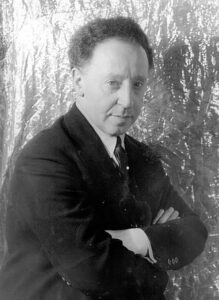
Arthur Rubinstein (Jan. 28, 1887 – Dec. 20, 1982) was born in Lodz, Poland, to a small textile factory owner Izaak Rubinstein and his wife Felicja Blima (Heiman) Fajga. At age 4, his piano playing brought him recognition as a child prodigy. At age 7, Rubinstein debuted as a concert pianist performing pieces by Mozart, Schubert and Mendelssohn. He moved to Berlin to continue his studies and performed at the age of 13 with the Berlin Philharmonic. On the recommendation of violinist Joseph Joachim, young Rubinstein studied piano with Karl Heinrich Barth, who had been a pupil of Franz Liszt.
In 1904, Rubinstein moved to Paris where he met composers Maurice Ravel and Camille Saint-Saens, among other musical luminaries. He made his New York debut at Carnegie Hall in 1906, but he was not well received in the United States. Improverished, discouraged, and facing eviction from his Berlin hotel room, he failed in an attempt to hang himself in 1908.
He later said he felt reborn after that episode and endowed with an unconditional love of life. In 1912, he became a regular at the musical salon of Paul and Muriel Draper, who also nourished the musical talents of Igor Stravinski, Pablo Casals and others. After World War I, his concertizing was widely acclaimed in Spain and South America. He toured the world in the interwar years, moving to the Brentwood section of Los Angeles during World War II. He was naturalized as an American citizen in 1946.
Although a concert soloist, Rubinstein also enjoyed performing as a chamber musician, partnering with Henryk Szeryng, Jascha Heifetz, Pablo Casals, Gegor Piatigorsky and the Guarneri Quartet. Considered one of the finest interpreters of Chopin, most of whose works he recorded, Rubinstein gave a well received all-Chopin concert in Moscow in 1964. In 1969, an Academy Award winning documentary, Artur Rubinstein — The Love of His Life, was produced. Worsening eyesight forced Rubinstein’s retirement in May 1976, after giving his last concert at London’s Wigmore Hall, where he had played nearly 70 years before.
In 1932, Rubinstein married ballerina Nela Mlynarska who was 21 years younger than he. They had five children including photographer Eva Rubinstein and actor John Rubinstein. Although he and Nela never divorced, Rubinstein left her in 1977. at age 90, for Annabelle Whitestone, who was then 33. With his wife and children he visited Israel several times, concertizing with the Israel Philharmonic Orchestra and giving master classes at the Jerusalem Music Centre. A year after he died in Geneva, and was cremated, an urn holding his ashes was buried in a plot in what Jerusalem Mayor Teddy Kollek dubbed the “Rubinstein Forest” overlooking the Jerusalem Forest. Streets were named for him in Tel Aviv, Israel and in Lodz and Bialogard, Poland.
Tomorrow, January 29: Adam Lambert
*
SDJW condensation of a Wikipedia article
Artur Rubinstein was my hero growing up as a young aspiring pianist. His story about his Love of Life always cheered me up and gave me confidence. But as a middle-aged adult, I now reflect on his attempted suicide a bit differently. Today, he might have told that story a bit differently. He made a kind of joke about how the belt broke and he came down “very heavily”. I hope that, nevertheless, he would maintain his good sense of humor about it.